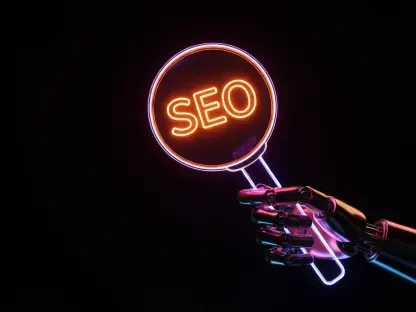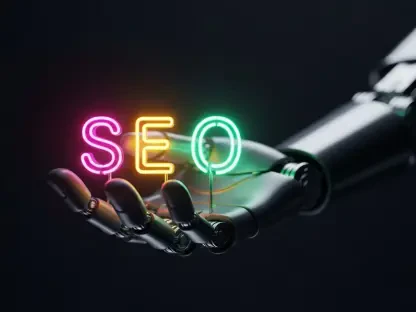The Evolution of Digital Marketing: From SEO to GEO
In the rapidly shifting landscape of digital marketing, a staggering statistic reveals the pace of change: traffic from chatbots and AI-driven search engines has surged by over 500 percent in recent years, signaling a profound transformation in how brands reach their audiences. This evolution marks a pivotal transition from traditional Search Engine Optimization (SEO), which dominated online visibility strategies for decades, to Generative Engine Optimization (GEO), a new frontier tailored for AI-powered interactions. As consumer preferences pivot toward instant, conversational responses, the industry stands at a critical juncture, redefining how brands connect with their audiences.
This shift reflects deeper changes in user behavior, where reliance on AI chatbots and large language models for search and shopping continues to grow. Unlike the keyword-heavy focus of SEO, GEO adapts to the conversational nature of AI tools, prioritizing content that aligns with precise, query-based interactions. The implications are vast, as brands must now rethink strategies to maintain relevance in a space dominated by technology rather than traditional search result rankings.
Key players like OpenAI, through partnerships with retail giants such as Walmart, exemplify the momentum behind this change. Technological advancements, including AI-driven search tools like ChatGPT, are reshaping the digital marketing ecosystem. These developments highlight a broader trend where innovation drives not just visibility, but also direct consumer engagement, setting the stage for a new era in how products and services are discovered online.
Understanding the Rise of Generative Engine Optimization
Key Trends Shaping GEO
The ascent of GEO is fueled by several defining trends, with the increasing adoption of AI chatbots for targeted, specific queries leading the charge. Consumers now turn to these tools to compare product features or seek detailed recommendations, bypassing broader search engine results. This behavior underscores a fundamental shift in how information is sought, placing emphasis on immediacy and relevance over expansive content.
Another significant trend is the heightened use of AI tools during peak shopping periods, such as the holiday season, for product discovery. Shoppers leverage chatbots to navigate deals and options swiftly, a pattern that challenges brands to ensure their offerings are easily accessible in AI responses. This dynamic illustrates the urgency for marketers to adapt content to meet the expectations of a more discerning, tech-savvy audience.
Technological progress, particularly in AI-generated content, further shapes GEO by catering to the unique preferences of chatbots. These systems favor concise, structured formats like bulleted summaries and FAQ sections, which align with user demands for quick, digestible information. As a result, businesses are compelled to refine their digital presence, focusing on clarity and specificity to secure visibility in AI-driven conversations.
Market Growth and Projections
Data underscores the explosive growth of GEO, with chatbot and AI search engine traffic continuing to rise dramatically from current levels into the near future. Industry reports project the GEO sector to reach a valuation of nearly $850 million, reflecting its substantial economic impact on digital marketing. This trajectory signals a robust shift, as more companies invest in strategies to harness AI for consumer engagement.
Looking ahead, GEO holds the potential to transform retail and e-commerce through seamless shopping integrations. Partnerships, such as those enabling direct purchases within chat interfaces, point to a future where transactions occur without leaving the conversation window. This convergence of discovery and purchase capability is poised to redefine the customer journey, streamlining interactions for greater efficiency.
The forward-looking perspective suggests that GEO will continue to influence market dynamics, particularly as brands align with emerging platforms. From small businesses to global corporations, the push toward AI-optimized content is expected to intensify, fostering innovation in how products are presented and sold. Such developments promise to reshape competitive landscapes across industries.
Challenges in Adopting GEO Strategies
Transitioning from SEO to GEO presents notable complexities, particularly in the divergence of content prioritization between traditional search engines and AI systems. Recent analyses indicate that the overlap between top Google results and sources cited by AI chatbots has plummeted to below 20 percent, a stark contrast to previous alignment. This discrepancy demands a fundamental overhaul in how content is crafted and positioned for visibility.
Another hurdle lies in measuring the return on investment (ROI) for GEO-specific content, especially in its early stage. Unlike SEO, where metrics like click-through rates offered clear insights, the impact of GEO often remains intangible in early adoption phases. Marketers face the challenge of quantifying success when immediate sales are not the primary outcome of AI-driven interactions.
Potential solutions to these obstacles include prioritizing consumer awareness over instant conversions, allowing brands to build a foundation in AI responses. Additionally, refining content to match chatbot preferences for specificity and structured formats can enhance discoverability. These approaches, while exploratory, offer a pathway to navigate the uncertainties of GEO implementation with a focus on long-term gains.
Regulatory and Compliance Considerations in GEO
The integration of AI-driven marketing through GEO brings with it a complex regulatory landscape, particularly concerning data privacy. As chatbots handle vast amounts of user information, ensuring compliance with global standards becomes paramount to avoid legal pitfalls. Brands must navigate these waters carefully to safeguard both their operations and consumer trust.
Evolving standards in e-commerce, especially with deepening AI integrations like partnerships between technology firms and retailers, add another layer of scrutiny. Regulatory bodies are increasingly focused on how personal data is utilized within conversational platforms, pressing companies to adhere to strict guidelines. This environment necessitates proactive measures to align GEO practices with legal expectations.
Transparency and security remain critical in maintaining consumer confidence as GEO strategies expand. Brands are urged to clearly communicate how data is processed within AI interactions, fostering trust in an era of heightened scrutiny. Addressing these concerns not only mitigates risks but also positions companies as responsible stewards of technological advancement in marketing.
The Future of Digital Marketing with GEO
Looking toward the horizon, GEO is set to redefine brand engagement by leveraging AI-driven platforms for deeper consumer connections. The potential for personalized, real-time interactions within chat environments offers a glimpse into a marketing landscape where relevance and immediacy reign supreme. This shift promises to elevate how businesses communicate value to their audiences.
Emerging opportunities, such as enabling direct purchasing within chat windows, highlight the innovative pathways GEO can unlock. Beyond transactions, the role of creative content tailored for AI systems will likely grow, pushing marketers to experiment with formats that resonate in conversational contexts. These advancements signal a future rich with possibilities for enhanced user experiences.
External factors, including global economic conditions and evolving consumer preferences, will undoubtedly influence GEO’s trajectory. As markets fluctuate and user expectations adapt, flexibility in strategy becomes essential for sustained relevance. The interplay of these elements will shape how GEO matures, challenging brands to remain agile in a technology-centric marketing world.
Conclusion: Embracing the GEO Revolution
Reflecting on the insights gathered, it becomes evident that GEO plays a pivotal role in reshaping digital marketing by aligning with an AI-dominated search landscape. The urgency for brands to adapt is clear, as staying relevant demands a departure from traditional SEO tactics toward content suited for chatbot interactions. This transition, though challenging, marks a significant milestone in how consumer discovery unfolds.
Moving forward, businesses are encouraged to take actionable steps by investing in structured, specific content that caters to AI preferences. Forming strategic partnerships with technology leaders offers another avenue to amplify presence in conversational platforms. These efforts lay the groundwork for sustained visibility in an evolving digital space.
Ultimately, the journey of GEO adoption points to a broader need for continuous innovation and adaptability. Exploring hybrid strategies that balance awareness with emerging direct sales opportunities surfaces as a practical next step. By embracing these considerations, brands position themselves to thrive amid the ongoing revolution in digital engagement.









